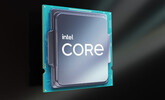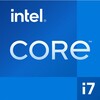Intel Core i5-11400F vs Intel Core i7-1270P
Intel Core i5-11400F
► remove from comparison
The Intel Core i5-11400F is a fast six-core desktop processor based on the new Rocket Lake architecture, which was introduced in March 2021. The processor clocks with a base clock of 2.6 GHz and reaches an all-core boost of 4.2 GHz under load. In single-thread applications, the Intel Core i5-11400F even reaches up to 4.4 GHz. Intel also gives the Rocket Lake processors the Hyperthreading feature, which allows the i5-11400F to process up to 12 threads simultaneously. As known, the Intel Core i5-11400F is manufactured in the 14 nm process. Nevertheless, many changes have been made with the Rocket Lake architecture, which is also reflected in the performance compared to the Comet Lake. The Intel Core i5-11400F is a non-K CPU, which means that there is no freely selectable multiplier. Thus, the scope for overclocking is relatively small.
Performance
Compared to the Intel Core i5-10400F, the Core i5-11400F offers a significantly better IPC. This can be seen clearly in the single-core benchmarks. But the multi-core performance also benefits from the better IPC compared to Comet-Lake. A performance increase of up to 20 percent can be expected. The Core i5 has to do without the TVB (Thermal Velocity Boost). However, 4.2 GHz is still possible when all cores are loaded. Due to the very high single-thread performance, the Intel Core i5-11400F is best suited for video games.
Graphics
The processors marked with "F" in the nomenclature don't offer an integrated graphics unit. All other non-F processors can fall back on the Intel UHD Graphics 750 and also allow operation without a dedicated graphics card.
Power consumption
The TDP turns out relatively low with 65 watts. This is the PL1 value. For Turbo, the Intel Core i5-11400F offers a higher TDP of up to 154 watts with PL2. However, this may only be applied for a maximum of 28 seconds (dew). A good air cooler should be able to handle the resulting waste heat, so no AiO is necessary for this processor.
Intel Core i7-1270P
► remove from comparison
The Intel Core i7-1270P is a higher-end Alder Lake-P family CPU, an expensive 28 W part meant for use in ultra-light, ultra-thin (yet actively cooled) laptops. This CPU was announced in early 2022 and it has 4 performance cores as opposed to the 6 cores of the top-of-the-line 1280P (P-cores, Golden Cove architecture) mated to 8 efficient cores (E-cores, Gracemont architecture). The P-cores are Hyper-Threading-enabled for a total of 16 threads when combined with the E-cores. The clock speeds range from 2.2 GHz to 4.8 GHz for the performance cluster and 1.6 GHz to 3.5 GHz for the efficient cluster. Full vPro feature set is supported by this Core i7 ("Enterprise" tier, allowing for remote device management). Its shortcomings as compared with the mighty i7-1280P include the smaller L3 cache, lower core count, lower clock speeds; the performance is slated to be significantly lower as a result.
A brief look at the specifications instantly reveals this i7 series chip to be very similar to the Core i5-12600H, a more power-hungry processor targeted at gaming laptops.
Architecture
The i7 is a continuation of Intel's efforts to use the ARM-developed big.LITTLE technology for its own benefit. A single "little" Alder Lake core is supposed to be as fast as a Skylake core (as found in the venerable Core i7-6700HQ among other options) which is six years old at this point. All of an Intel Core i7-1270P's CPU cores enjoy access to 18 MB of L3 cache. The integrated memory controller supports various memory types up to LPDDR5-5200, DDR5-4800, LPDDR4x-4267 or DDR4-3200. Intel suggests using no more than 64 GB, for reference. Just like the other 12th Gen Intel Core processors, Core i7-1270P comes with Thread Director which is a new functionality designed to help Windows 11 decide which cores to use for what workload for best performance and efficiency possible. Hardware acceleration of AI algorithms is supported via GNA 3.0 and DL Boost (via AVX2). PCI-Express 5.0 support has not found its way into Alder Lake P processors, so users will have to be content with PCI-Express 4.0 for the time being. Four PCI-Express 4 lanes allow for a read/write rate of up to 7.9 GB/s, provided a suitably fast NVMe SSD is used.
Please note this is not a user-replaceable CPU. It gets soldered permanently on to the motherboard (BGA1744 socket interface).
Performance
The 12 CPU cores are not just able to outshine any outgoing quad-core Tiger Lake part, the i7-1195G7 included. The average 1270P in our database directly competes with the Ryzen 7 5825U, the Ryzen 7 7730U and the Ryzen 7 7735U, meaning this little Core i7 is fast enough to make most consumers happy as of mid 2023.
The fairly high processing power comes at a cost. A single Golden Cove core can consume more than 20 W when under heavy load. Your mileage may thus vary depending on how high the Power Limits are and how competent the cooling solution of your laptop is.
Graphics
The built-in graphics adapter in the form of the 96 EU Iris Xe running at up to 1.40 GHz has seen no change from what was built into the 11th Gen Tiger Lake-UP3 processors, like an i7-1165G7, which is hardly a downside as this iGPU is loaded with modern features such as AV1 video decoding capability and SUHD 4320p monitor support. Up to 4 monitors can be used simultaneously with this iGPU. We expect the gaming performance to be reasonably close to that of NVIDIA's MX350.
In other words, the Xe is good enough for most games at 1080p resolution / Medium settings, provided the Power Limits are high enough and the cooling solution is competent enough. Fast RAM is a prerequisite for decent performance as well (the Xe has to make do with no dedicated video memory).
Last but not the least, we discovered that the GPU utilization when playing YouTube UHD 2160p60 videos is higher than it was with Tiger Lake chips.
Power consumption
The i7's base power consumption (also known as the default TDP or Power Limit 1) is 28 W, with 64 W being its maximum Turbo power consumption (also known as the PL2). As for the "Minimum Assured" power consumption, Intel's guidelines mention 20 W. All in all, an active cooling solution is a must for such a chip.
The CPU is built with Intel's fourth-gen 10 nm process marketed as Intel 7 for decent, as of late 2022, energy efficiency. It's still a rather power-hungry CPU; a single P-core will happily consume more than 20 W when under heavy load. A couple of the higher-end 7 nm U-class AMD Ryzen 5000 chips are not nearly as power-hungry while delivering similar or higher performance levels.
| Model | Intel Core i5-11400F | Intel Core i7-1270P | ||||||||||||||||||||||||||||||||||||||||||||||||
| Codename | Rocket Lake | Alder Lake-P | ||||||||||||||||||||||||||||||||||||||||||||||||
| Series | Intel Rocket Lake | Intel Alder Lake-P | ||||||||||||||||||||||||||||||||||||||||||||||||
| Series: Alder Lake-P Alder Lake-P |
|
| ||||||||||||||||||||||||||||||||||||||||||||||||
| Clock | 2600 - 4400 MHz | 1600 - 4800 MHz | ||||||||||||||||||||||||||||||||||||||||||||||||
| L1 Cache | 480 KB | 1.1 MB | ||||||||||||||||||||||||||||||||||||||||||||||||
| L2 Cache | 3 MB | 10 MB | ||||||||||||||||||||||||||||||||||||||||||||||||
| L3 Cache | 12 MB | 18 MB | ||||||||||||||||||||||||||||||||||||||||||||||||
| Cores / Threads | 6 / 12 | 12 / 16 | ||||||||||||||||||||||||||||||||||||||||||||||||
| TDP | 65 Watt | 28 Watt | ||||||||||||||||||||||||||||||||||||||||||||||||
| Technology | 14 nm | 10 nm | ||||||||||||||||||||||||||||||||||||||||||||||||
| Die Size | 276 mm2 | |||||||||||||||||||||||||||||||||||||||||||||||||
| max. Temp. | 100 °C | 100 °C | ||||||||||||||||||||||||||||||||||||||||||||||||
| Socket | LGA1200 | BGA1744 | ||||||||||||||||||||||||||||||||||||||||||||||||
| Features | DDR4-3200 RAM, PCIe 4, 8 GT/s bus, DL Boost, GNA, MMX, SSE, SSE2, SSE3, SSSE3, SSE4.1, SSE4.2, AVX, AVX2, AVX-512, BMI2, ABM, FMA, ADX, VMX, SMEP, SMAP, MPX, EIST, TM1, TM2, HT, Turbo, SST, AES-NI, RDRAND, RDSEED, SHA | DDR4-3200/LPDDR4x-4266/DDR5-4800/LPDDR5-5200 RAM, PCIe 4, Thr. Director, DL Boost, GNA, Rem. Platf. Erase, MMX, SSE, SSE2, SSE3, SSSE3, SSE4.1, SSE4.2, AVX, AVX2, BMI2, ABM, FMA, ADX, SMEP, SMAP, EIST, TM1, TM2, HT, Turbo, SST, AES-NI, RDRAND, RDSEED, SHA | ||||||||||||||||||||||||||||||||||||||||||||||||
| Architecture | x86 | x86 | ||||||||||||||||||||||||||||||||||||||||||||||||
| $157 U.S. | ||||||||||||||||||||||||||||||||||||||||||||||||||
| Announced | ||||||||||||||||||||||||||||||||||||||||||||||||||
| Manufacturer | ark.intel.com | ark.intel.com | ||||||||||||||||||||||||||||||||||||||||||||||||
| iGPU | Intel Iris Xe Graphics G7 96EUs ( - 1400 MHz) |
Benchmarks
Average Benchmarks Intel Core i5-11400F → 100% n=33
Average Benchmarks Intel Core i7-1270P → 101% n=33
* Smaller numbers mean a higher performance
1 This benchmark is not used for the average calculation












